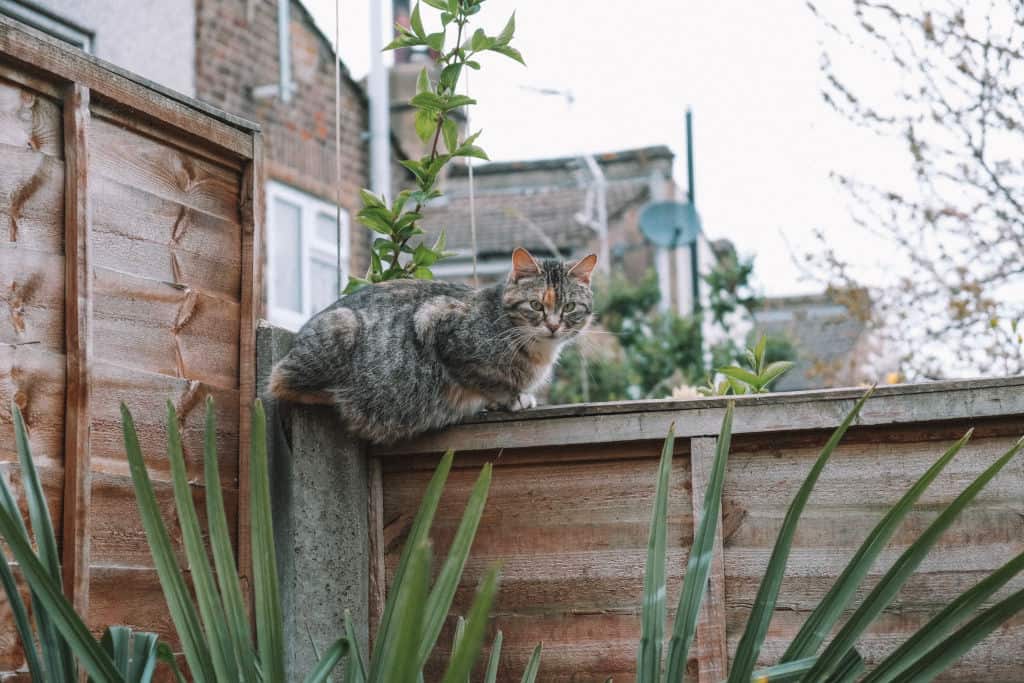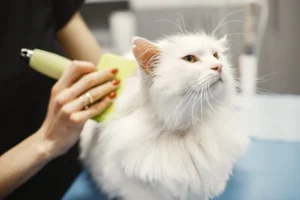Disclosure: We may earn a commission from helpful, relevant links in our content. No cost to you. See our privacy policy.
A neighbor’s cat visiting is a common thing that happens to many of us. There are many reasons a neighbor’s cat might come to your house.
This article explains why a neighbor’s cat comes to your house, what to do, and how to stop it from coming over.

Why Does a Neighbor’s Cat Come To Your House?
There are many reasons why a neighbor’s cat might come to your house. Some possible reasons include:
- Food or water
- Social interaction
- Scent of other cats/animals
- Marking territory
- Escape from something
- Being lost.
Indoor/outdoor cats frequently pick where they spend their time and visit various households for food and petting.
My elderly cat would treat both of my neighbors’ homes as though they were his own. We later learned he was sneaking into a property down the road through a dog door. He’d eat their dog’s food and then go to another place.
Cats do not see boundaries in the same way that humans do. Your house is certainly within their territory because of any place in their region they consider theirs. The cat could be roaming the territory and leaving its scent in new spots.
Remember, if a neighbor’s cat consistently finds its way into your home, it’s likely that it views your place as an extension of its domain, perhaps offering comforts or attractions that its primary residence might not.
Moreover, cats in crowded settings (such as porches) frequently share territory. If you have cats, this presumably means that this region is shared by your cats and possibly the cats next door unless your cat often prevents their entry.
Similarly, the aroma of other cats or animals in your yard may attract the cat looking for potential mates or rivals. If you have other pets, be cautious because there are numerous dangers to be aware of.
The cat could also be fleeing something, and your house could be a secure sanctuary to hide. In fact, many homeowners note that when a neighbor’s cat repeatedly enters their home, it’s often due to familiar scents or the allure of a quieter, less chaotic environment.
It’s also possible that the cat is lost and trying to find its way home.
What to Do When a Neighbor’s Cat Visit You?
When a neighbor’s cat visits you, there are a few things you can do:
- Determine if it’s stray or lost
If the cat is not wearing a collar or does not have a microchip, it may be a stray. It’s a good idea to check with your neighbors to see if the cat is lost or belongs to them.
- Talk to the neighbor.
If the cat actually belongs to your neighbor, talk with them first. You can let the cat in if everything is fine and the cat has been vaccinated. Ask your neighbor whether you may feed the cat anything or give it treats.
- Provide food and water
If the cat is visiting your house because of hunger, you can give it a small amount of food and water to ensure the cat is provided with the essential resources.
- Be aware of the cat’s health and behavior.
Ensure the cat is vaccinated, especially against rabies, since he is an outdoor or indoor/outdoor cat. These cats are at a higher risk of catching a disease outdoors, and it’s even more dangerous if the cat comes into contact with your other pets. Kittens as susceptible, too.
- Respect local laws
Be aware of local laws regarding stray cats and ensure you are not breaking any laws by helping the cat. Unless you’ve talked to the owner and know the cat is owned, you should be aware of any feeding bans regarding strays or outdoor house cats.
Some cats live quite well by going to different houses and getting food and treats. If the cat is only looking for food and pets, and you’re allowed to provide that, there’s nothing wrong with this, but remember that the cat will probably keep coming for more.

How to Stop the Neighbor’s Cat From Coming Over?
Here are a few ways to stop a neighbor’s cat (or any other cat) from coming over to your property:
- Use smell to deter a cat (coyote urine, citrus, etc.)
- Use a sprinkler with a motion sensor
- Put sticky tape on the fence or entrance
- Plant rosemary and thyme
A humane way to deter a cat is with a smell. Get granulated coyote urine online or from a local plant/nursery store. It is available in both liquid and pellet form. Cats detect this as a natural predator and avoid it for their safety. It is a low-cost solution that works effectively for house and wild cats.
Because it’s granular, you won’t notice it, but the cats will. Sprinkle it around your yard, paying close attention to fence openings or other entry points. After it rains, re-sprinkle it.
If you’re afraid about attracting other coyotes, don’t be. Because the repellant is made from only male coyote urine, it does not attract additional coyotes to the region. Remember that this is usually a temporary solution that will only work for a limited time.
Another way is to use a sprinkler with a motion sensor that will turn on whenever a cat appears. You can get one on Amazon or Walmart. They can be highly effective with many animals, not just cats, but may require some adjusting at first.
You can adjust sprinklers for distance. Some merely cover half or a quarter of the sphere. You can play about with them to make sure it doesn’t block the way of other people, such as the mail carrier or other visitors.
This strategy, however, has a few drawbacks. For starters, they frequently have a limited range (20-30 ft). Second, the cat will learn to avoid the spray and the patterns, requiring frequent relocation of the sprinkler. Finally, the sprinkler will spray anyone who enters the sensor, including you.
If you don’t want to spray cats with water, try a few other ways.
If the cat continues to jump on the fence in the same area, apply some sticky tape. Make the barrier unappealing to the cat, and it will avoid it. Cats dislike having something attached to their paws, so we use this method to keep cats from leaping on the kitchen counter.
Finally, you try planting rosemary and thyme. Many cats (though not all) dislike this smell and will stay away from it. Both plants are NON-toxic to cats and dogs and completely safe, according to ASPCA.
FAQs
Is it illegal to feed your neighbor’s cat?
Feeding your neighbor’s cat is not typically illegal, but local ordinances or bylaws may prohibit or regulate feeding stray or feral animals. Giving someone else’s cat food might result in several issues, such as providing it with something to which the cat is allergic.
How to tell if the cat is owned or a stray?
To tell if a cat is owned or stray, look for a collar with tags, a microchip, a groomed appearance, friendly behavior, regular visits, and ask neighbors if they recognize it. Check for a pattern of behavior. If it has a routine of visiting, it’s more likely to be a pet cat.
What does it mean when a cat comes to you?
A cat coming to you may be looking for food, affection, companionship, protection, or marking its territory. Observe the cat’s behavior and body language to understand the meaning. A regular visitor may have formed a bond with you and seeking your company.
Alex, a passionate animal lover, has experience in training and understanding animal behavior. As a proud pet parent to two dogs and three cats, he founded AnimalReport.net to share insights from animal experts and expand his knowledge of the animal kingdom.




